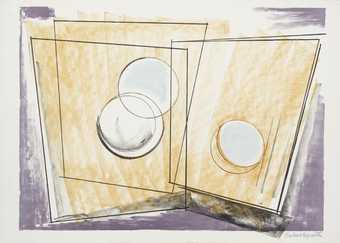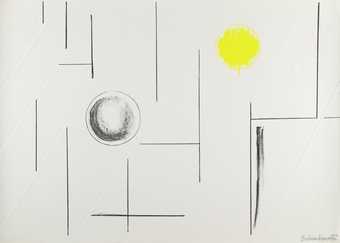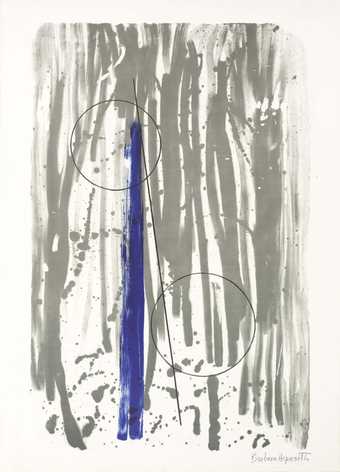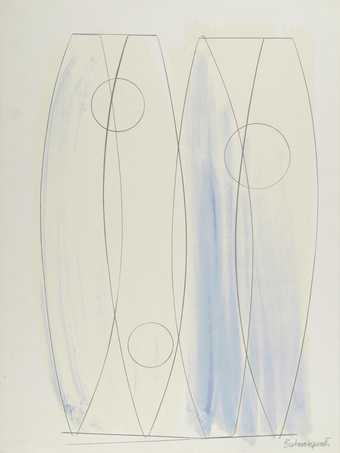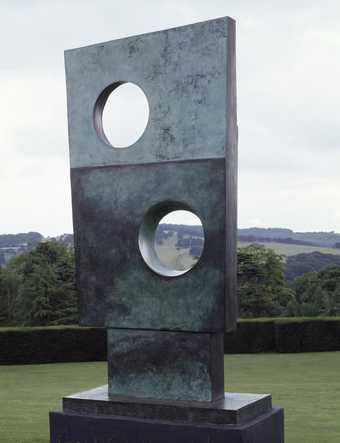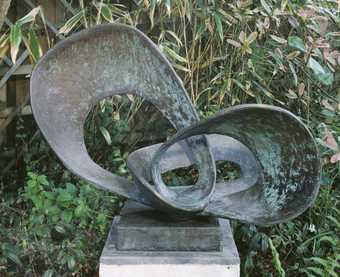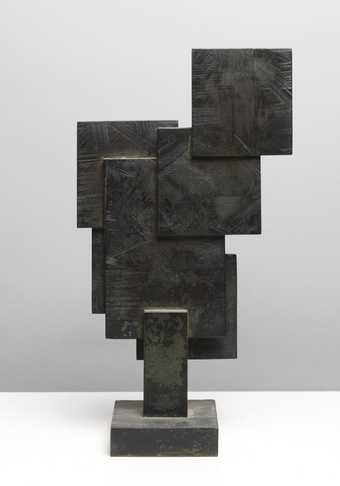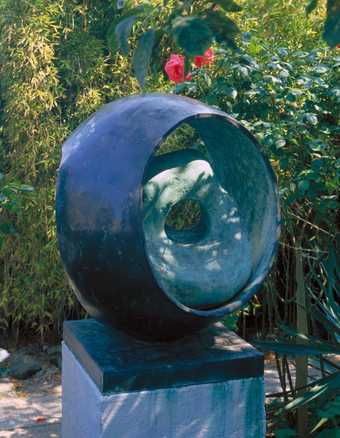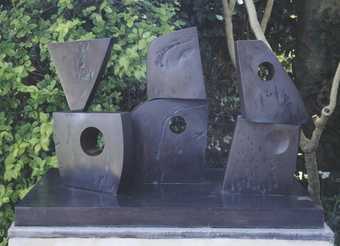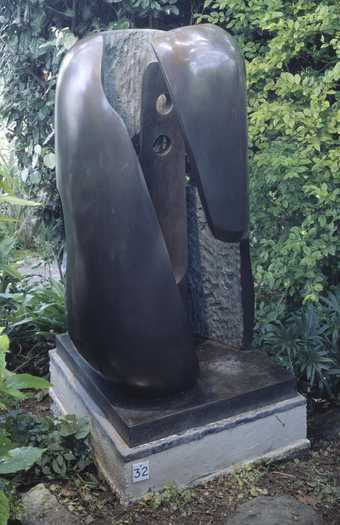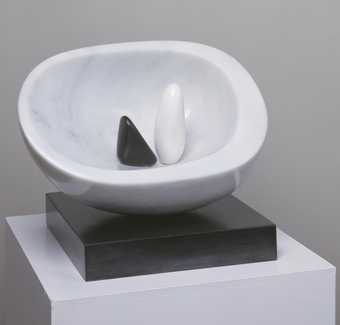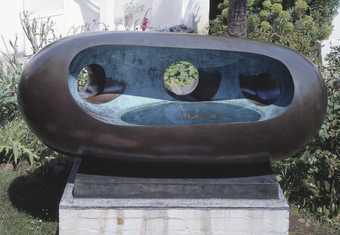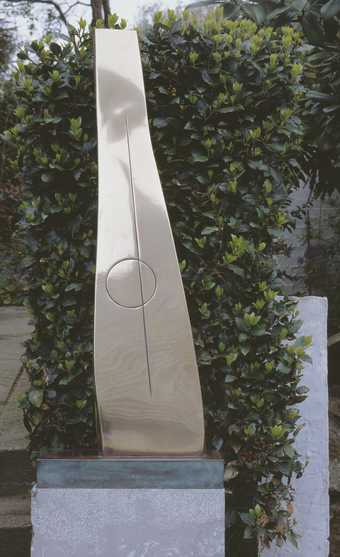
In Barbara Hepworth Museum and Sculpture Garden
- Artist
- Dame Barbara Hepworth 1903–1975
- Medium
- Bronze
- Dimensions
- Object: 2175 × 2355 × 546 mm
- Collection
- Tate
- Acquisition
- Presented by the executors of the artist's estate 1980
- Reference
- T03149
Catalogue entry
Dame Barbara Hepworth
1903-1975
T03149 Two Forms (Divided Circle)
1969
BH 477; cast 0/6
Bronze on a bronze base 2370 x 2340 x 543 (93 1/2 x 92 x 21 1/4)
Cast inscription on front face of base 'Barbara Hepworth 1969 0/6' l. and 'Morris | Singer | FOUNDERS | LONDON' r.
Presented by the executors of the artist's estate, in accordance with her wishes, 1980
Exhibited (ý = unidentified cast, ü = other cast):
Barbara Hepworth: Recent Work, Sculpture, Paintings, Prints, Marlborough Fine Art, Feb.-March 1970 (19ý, repr. in col. on cover)
Open-Air Sculpture II, Gimpel Fils exhibition in Syon Park, summer 1970 (11ü, repr. in col. on cover)
Barbara Hepworth, Plymouth City Art Gallery, June-Aug. 1970 (54ü)
Barbara Hepworth Exhibition, 1970, Hakone Open-Air Museum, Japan, June-Sept. 1970, (31ü, repr. in col.)
Barbara Hepworth, Gimpel Gallery, New York, March-April 1971 (9ý, repr.)
Masters of the 19th and 20th Centuries, Marlborough Fine Art, summer 1972 (31ý, repr. in col. p.63)
Barbara Hepworth: Late Works, Edinburgh Festival Society, Royal Botanic Garden, Edinburgh, Aug.-Sept. 1976 (9ý, repr. in col.)
Barbara Hepworth, Yorkshire Sculpture Park, Bretton Hall, July-Oct. 1980 (22ü, repr. p.26)
Literature:
Alan Bowness (ed.), The Complete Sculpture of Barbara Hepworth 1960-69, 1971, p.48 no.477, pls.15 (col.), 189-90
'News and Notes: Hepworth Sculpture in Dulwich', Studio International, vol.181, no.933, May 1971, pp.197-8
David Fraser Jenkins, Barbara Hepworth: A Guide to the Tate Gallery Collection at London and St Ives, Cornwall, 1982, p.19, repr. p.39
Tate Gallery Acquisitions 1980-2, 1984, p.123, repr.
W.J. Strachan, Open Air Sculpture in Britain: A Comprehensive Guide, 1984, p.47, no.51, p.113, no.225, repr. pp.48, 113
Reproduced:
Bijutsu Techo, Aug. 1970, p.1 (in col.)
A.M. Hammacher, Barbara Hepworth, 1968, rev. ed. 1987, p.201, pl.179
Marianne Hancock, 'Barbara Hepworth', Arts, vol.45, no.7, May 1971, p.59
Caroline Tisdall, obituary, Guardian, 22 May 1975, p.10
Peter Davies and Tony Knipe, eds., A Sense of Space: Sculpture in Landscape, 1984, p.82, repr. in col.
Michael Tooby, An Illustrated Companion to the Tate St Ives, 1993, p.12
Sally Festing, Barbara Hepworth: A Life of Forms, 1995, between pp.280 and 281, pl.66
Displayed in the artist's garden, Barbara Hepworth Museum, St Ives
The 1960s was a period of 'tremendous liberation', Barbara Hepworth told Alan Bowness: 'I at last had space and money and time to work on a much bigger scale. I had felt inhibited for a very long time over the scale on which I could work ... It's so natural to work large - it fits one's body' (Bowness 1971, p.7). The decade began with the large scale Figure for Landscape, 1960 (Tate Gallery T03140), encompassed works designed to include the viewer, such as Four Square (Walk Through), 1966 (BH 433, Estate of the artist, on loan to the Barbara Hepworth Museum, St Ives [Tate Gallery L00937], repr. ibid., pl.160-1) and Three Obliques (Walk In), 1968 (BH 473, University College, Cardiff, repr. ibid., pl.183), and ended with Two Forms (Divided Circle). This work falls between the monolithic and the environmental sculptures in that its bifurcated form seems to draw the viewer in while the narrow spacing between the two halves denies a passage through. The ambiguity may be related to Hammacher's belief that Hepworth's 'conception of space ... is indeed to be found in the openings (the no-door, the door-angst) towards the infinity of emptiness' (Hammacher 1968, 2nd ed. 1987, p.200). This quality, combined with the apparently precarious angle of the two forms, gives the sculpture a sense of dramatic tension.
Two Forms (Divided Circle)
is an unexpectedly asymmetrical work. Its slightly awkward quality is enhanced by the disposition of the individual elements: set at an angle to each other and stepped one slightly behind the other. Unlike many of Hepworth's sculptures, with Two Forms
it is not possible to identify a single frontal face as both display the narrow and wider ends of the two openings. One of the semi-circular sections is pierced by a cylindrical hole which, on one side, is set within a semi-circular concavity. In the neighbouring form, the hole spirals from a circle to an oval. Photographs show these recessed areas to have been highly polished and, even though the Tate's work has tarnished, the internal surfaces are more golden in colour than the thin green patination of the exterior. Traces of lacquer, which has disintegrated, suggest that the artist wanted to retain the shine on the inner surfaces even while out of doors. Microscopic analysis revealed these to contain yellow ochre and cadmium yellow pigments, which were presumably intended to tone the polished bronze (J[ackie] Heuman, 'Perspectives on the Repatination of Outdoor Bronze Sculptures' in Phillip Lindley (ed.), Sculpture Conservation: Preservation or Interference?, Aldershot 1997, pp.124-5, repr. [p.221], pls.XXVIII, before weathering, XXIX, col.). Tate Gallery conservators and the artist's executors have discussed the possibility of polishing and relacquering the bronze (Tate Gallery conservation files). The base has a stippled blue/black patina. The two semi-circles taper towards the bottom and their outer edge. While the sides are smooth, their larger, slightly convex, faces bear the texture of the carving of the original plaster. As well as evenly distributed curving lines, there are rectilinear groups of dots, perhaps made with a claw, and a fine regular texture, as if sacking had been pressed on to the wet plaster. All three elements of the sculpture are hollow cast and the two main forms are welded to the base.
Reflecting developments in the environmental art of the 1960s, Hepworth explained that with the large sculptures of the second half of the decade she sought to involve the viewer in the work. She insisted that one's whole body should be engaged with the sculpture as it 'helps to orientate us - give us an image of security and a sense of architecture' (Edwin Mullins, 'Scale and Monumentality', Sculpture International, vol.4, no.1, 1967, p.20). She included this work among those under discussion: 'You can climb through the Divided Circle
- you don't need to do it physically to experience it' (Bowness 1971, p.12). The artist told Ben Nicholson how she conceived of these works in physical and visual terms: 'So much depends, in sculpture, on what one wants to see through a hole!' she wrote. 'Maybe in a big work I want to see the sun or moon. In a smaller work I may want to lean in the whole ... It is the physical sensation of piercing and sight which I want' (letter, 22 dec. 1967, TGA 8717.1.1.371). Though she had already made several monumental pieces, the artist related these large works to her diagnosis of cancer in 1966. 'It was the same in 1938', she said, 'If war is imminent, or you're very ill or something's threatening, you want to put something down for big work while you can. I was in an absolute fever of ideas, without much hope of fulfilment' (ibid., p.12).
Hepworth insisted that she did not work from maquettes as sculptures could not simply be scaled-up (Mullins 1967, p.21). Nevertheless, as with works such as Four Square (Walk Through), she made a smaller version of Two Forms (Divided Circle). At 369 mm (14 1/2 ins) high, Maquette for Divided Circle
(BH 478, Barbara Hepworth Estate, repr. Bowness 1971, p.49) was cast in polished bronze in an edition of nine. Similar reworking of a single concept was common in her later work, as were small-scale, multi-part sculptures.
Just as numerous paintings and sculptures of the mid-1960s were based on the square, so the semi-circle recurs in Hepworth's works of 1969-72. Specifically, it was the basis for her 1970 design for a mural sculpture at the head offices of the Cheltenham & Gloucester Building Society in Cheltenham. Theme and Variation, 1970 (BH 511, repr. Barbara Hepworth: A Pictorial Autobiography, 1970, rev. ed. 1978, p.130) consists of superimposed semi-circular panels of bronze, of varying sizes, cascading or fanning out in three different configurations over the building's entrance. In 1969, Hepworth was glad to be one of 'a few sculptors of repute' who were invited to consider the commission as she had 'several ideas in mind for wall sculptures' (Penelope Curtis and Alan G. Wilkinson, Barbara Hepworth: A Retrospective, exh. cat., Tate Gallery Liverpool 1994, p.156). She had been frustrated a few years earlier by the rejection of her Three Forms in Echelon, 1963 (see Tate Gallery T00959
and T03142) for a similar scheme for the John Lewis store in London. She started work at the beginning of 1970, her design - which drew on her 1969 Aegean Suite of prints - was accepted in June and the building was opened in September 1972 (ibid.). In 1970 she also comissioned Breon O'Casey and Brian Ilsley, then working together as jewellery makers in St Ives, to produce a small version in silver on walnut (O'Casey, interview with the author, 16 Oct.1996). This is entitled Maquette, Theme and Variations
(BH 512a, Barbara Hepworth Estate, repr. ibid. p.129) but, in keeping with similar table-top versions of larger works, was most likely to have been an independent reworking of the same concept. In these works Hepworth used the semi-circular form to create the illusion of a rocking motion in a manner which echoed Terry Frost's paintings based upon the movement of boats in St Ives harbour, such as Green, Black and White Movement, 1951 (Tate Gallery T01501).
A cast of Two Forms (Divided Circle), purchased by the Greater London Council, is displayed in Dulwich Park (5/6) and another is in the collection of Bolton City Art Gallery (4/6).
Chris Stephens
March 1998
Film and audio
Explore
- abstraction(8,615)
-
- non-representational(6,161)
-
- geometric(3,072)
- formal qualities(12,454)
-
- space(177)
You might like
-
Dame Barbara Hepworth Oblique Forms
1969 -
Dame Barbara Hepworth Sea Forms
1969 -
Dame Barbara Hepworth Two Marble Forms (Mykonos)
1969 -
Dame Barbara Hepworth Four-Square (Walk Through)
1966 -
Dame Barbara Hepworth December Forms
1970 -
Dame Barbara Hepworth Squares with Two Circles
1963 -
Dame Barbara Hepworth Forms in Movement (Pavan)
1956–9, cast 1967 -
Dame Barbara Hepworth Square Forms
1962 -
Dame Barbara Hepworth Sphere with Inner Form
1963 -
Dame Barbara Hepworth Six Forms (2 x 3)
1968 -
Dame Barbara Hepworth Hollow Form with Inner Form
1968 -
Dame Barbara Hepworth Vertical Form (St Ives)
1968, cast 1969 -
Dame Barbara Hepworth Oval with Two Forms
1971 -
Dame Barbara Hepworth River Form
1965 -
Dame Barbara Hepworth Shaft and Circle
1973

